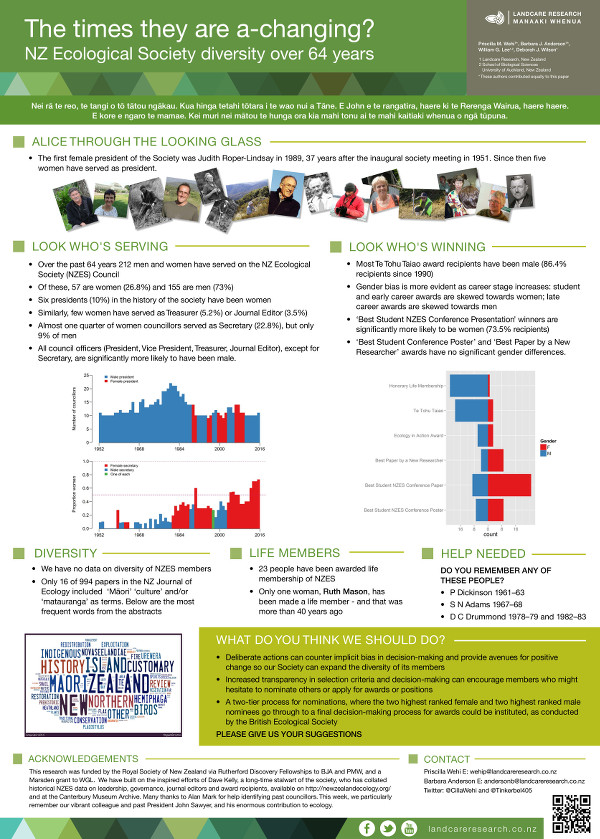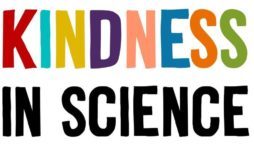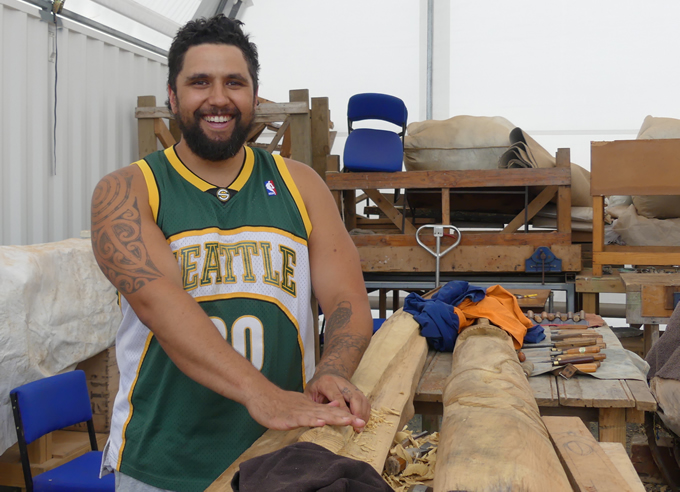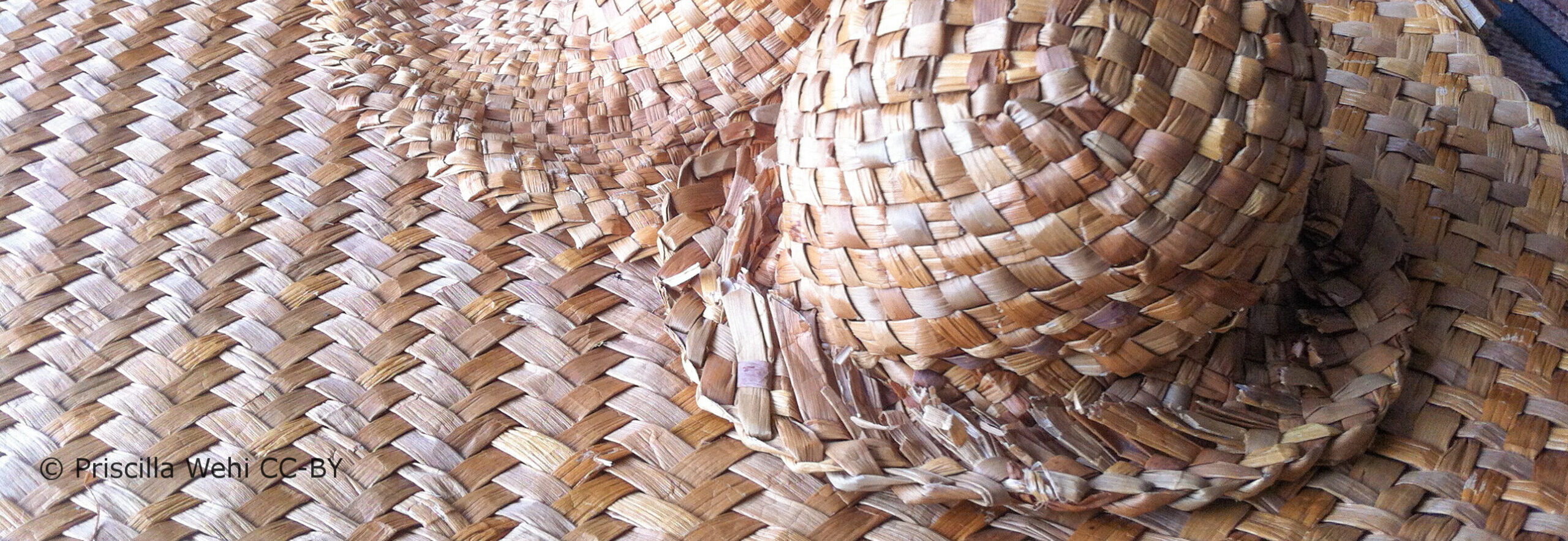 We stand at a critical juncture in history, where science has a multiplicity of voices who seek many kinds of knowledges, and where society plays a significant part in deciding how we go forward from here. A new generation of students is engaging with science in ways that were once rare, both in New Zealand and globally.
We stand at a critical juncture in history, where science has a multiplicity of voices who seek many kinds of knowledges, and where society plays a significant part in deciding how we go forward from here. A new generation of students is engaging with science in ways that were once rare, both in New Zealand and globally.
As a discipline, science has not always been welcoming of all. I have struggled with ‘belonging’ throughout my career. On this page, I highlight work that impacts the culture of science. This work incorporates aspirations to create a scientific community that has a kind and welcoming structure, and enables researchers to thrive and produce their best work. It also acknowledges cultural perspectives, enables community partnerships, and co-creates interdisciplinary knowledge. In this milieu, scientific leadership has a particular contribution. Thank you to all those who are working to change the culture of science.
Women in Science and Leadership
Women in our communities can lead change with transformational leadership. This article about Hana Harawira is a good introduction to the topic.
The story I tell in this video explains the importance of role models in science leadership.
 I have been inspired by many women scientists and their leadership. One of them is Professor Pat Langhorne at the Physics Department, the University of Otago, New Zealand who currently leads the the sea ice observations at the Deep South New Zealand’s National Science Challenge. In her interview with Curious Minds Professor Langhorne said: The greatest hope I have for the future is the enthusiastic intelligence of the young to bring about change and come up with innovative solutions. These solutions need diversity: cultural and ethnic diversity and most importantly balanced input from women and men.
I have been inspired by many women scientists and their leadership. One of them is Professor Pat Langhorne at the Physics Department, the University of Otago, New Zealand who currently leads the the sea ice observations at the Deep South New Zealand’s National Science Challenge. In her interview with Curious Minds Professor Langhorne said: The greatest hope I have for the future is the enthusiastic intelligence of the young to bring about change and come up with innovative solutions. These solutions need diversity: cultural and ethnic diversity and most importantly balanced input from women and men.
Indigenous Knowledge and Science
In this article published by The Science Learning Hub – Pokapū Akoranga Pūtaiao I speak about how I use both mātauranga Māori and western science in my research into Aotearoa New Zealand’s ecological past.

 In my PhD, I worked on traditional resource management of flax or harakeke (Phormium tenax) by Maori in New Zealand. As part of this work, completed in 2006, I interviewed some of our elders and weavers from Kawhia and Aotea in the western harbours of Waikato. Later, I examined harvesting more generally in the Waikato, and where practitioners harvest the plants they need and co-authored a paper about it “Traditional plant harvesting in contemporary fragmented and urban landscapes” (Wehi and Wehi 2010). I also examined some of the cultural uses of kuta (Eleocharis sphacelata), a wetland rush that is particularly valued by weavers in Northland. Hats, soft mats, and capes are just some of the taonga or treasured items with a distinctive golden colour made from this plant (Wehi 2006).
In my PhD, I worked on traditional resource management of flax or harakeke (Phormium tenax) by Maori in New Zealand. As part of this work, completed in 2006, I interviewed some of our elders and weavers from Kawhia and Aotea in the western harbours of Waikato. Later, I examined harvesting more generally in the Waikato, and where practitioners harvest the plants they need and co-authored a paper about it “Traditional plant harvesting in contemporary fragmented and urban landscapes” (Wehi and Wehi 2010). I also examined some of the cultural uses of kuta (Eleocharis sphacelata), a wetland rush that is particularly valued by weavers in Northland. Hats, soft mats, and capes are just some of the taonga or treasured items with a distinctive golden colour made from this plant (Wehi 2006).
In this video from the KuDoS Awards, I talk about my PhD research, and how “western” science and Indigenous Knowledge can work together.
Inequalities in Science

School children in New Zealand may not have equal opportunity to participate in science. We discuss this in detail in our paper “Participation in the Science Fair: a call for data“.
We analysed participation data from the Otago Science Fair to show that Otago students from low-decile schools (i.e. schools with more low income families) were far less likely to be participate in the Science Fair in comparison with students from high decile schools. These low decile schools also had high numbers of Māori students. The percentage of Māori students in each decile is shown on the top of each bar in the graph. The grey portion of each bar represents the number of schools that participated in the Science Fair from that decile, and the black portion represents the number of schools that did not participate.
 There is considerable evidence that scientific career is impacted by gender. This paper and an earlier poster show our analysis of participation by women in the NZ Ecological Society from its inception. Intersectional data on NZES members are lacking. However, few papers have been published in the NZ Journal of Ecology that incorporate mātauranga, with the exception of the 2019 special issue.
There is considerable evidence that scientific career is impacted by gender. This paper and an earlier poster show our analysis of participation by women in the NZ Ecological Society from its inception. Intersectional data on NZES members are lacking. However, few papers have been published in the NZ Journal of Ecology that incorporate mātauranga, with the exception of the 2019 special issue.
More broadly, there are many barriers that women and other marginalised groups in STEM face. See this review by Homeward Bound women on barriers in STEM.
Kindness in Science
Scientists and Climate Change
 Kindness in Science is an inclusive approach that fosters diversity, respect, wellbeing & openness leading to better science outcomes.
Kindness in Science is an inclusive approach that fosters diversity, respect, wellbeing & openness leading to better science outcomes.
I am a part of the founding group and strive to apply Kindness in Science principles in all areas of my work.

58 Rutherford Discovery Fellows issued a joint statement urging the New Zealand Government to declare a climate emergency.
Mātauranga and Antarctica
 We celebrated the beginning of a new Marine Protected Area in the Ross Sea at the end of 2017. This event led to research exploring the values and practice of kaitikaitanga in relation to the protection of Antarctic ecosystems. This booklet tells the story.
We celebrated the beginning of a new Marine Protected Area in the Ross Sea at the end of 2017. This event led to research exploring the values and practice of kaitikaitanga in relation to the protection of Antarctic ecosystems. This booklet tells the story. Whakairo is a traditional Māori art form that embeds values and history, and acts as a repository of knowledge. In 2018 a group of whakairo experts, communicators and scientists came together over the course of the year to explore both the ecology of the Ross Sea, and Māori relationships with Antarctica. In February 2019, James York and Poutama Hetaraka travelled to Antarctica to complete carving the sides and lintel of a door, which were unveiled at Scott Base. The whakairo draws attention to the partnership of mātauranga Māori and western scientific knowledge, using symbolism to reference the maramataka and global climate changes, and the contribution of scientists. It depicts the ongoing damage to Papatūānuku and calls for action on the part of the world’s leaders to address the major environmental problems that we now face. In these ways, perceptions of Māori relationships and environmental values are expressed and embedded in whakairo.
Whakairo is a traditional Māori art form that embeds values and history, and acts as a repository of knowledge. In 2018 a group of whakairo experts, communicators and scientists came together over the course of the year to explore both the ecology of the Ross Sea, and Māori relationships with Antarctica. In February 2019, James York and Poutama Hetaraka travelled to Antarctica to complete carving the sides and lintel of a door, which were unveiled at Scott Base. The whakairo draws attention to the partnership of mātauranga Māori and western scientific knowledge, using symbolism to reference the maramataka and global climate changes, and the contribution of scientists. It depicts the ongoing damage to Papatūānuku and calls for action on the part of the world’s leaders to address the major environmental problems that we now face. In these ways, perceptions of Māori relationships and environmental values are expressed and embedded in whakairo.
The story was covered by Māori Television and Te Karere TVNZ.
In this Science Learning Hub – Pokapū Akoranga Pūtaiao article I spoke more about the role of mātauranga in contemporary research.
The Whakairo project was supported by the Ngāi Tahu Fund. 
References
- Dattner F, Adams S, Alexander K, Cano M, Clarke K, Clarke K, Collins D, Conn C, Doyle B, Dubini A, Feeney M-E, Goh AMY, Gray T, Hann M, Hart M, Hessenberger D, Humanes A, Jahangir A, Lopez U, Oaten M, Payo Payo A, Pérez-Porro A, Sealey K, Taranovic V, Unterstell N, Verspoor K, Ward-Fear G, Wang L, and Wehi PM 2019. Mother Nature Needs Her Daughters: A Homeward Bound Global Review and Fact Sheet Investigating Gender Inequality in STEMM. Research report. Sydney, NSW: Centre for Educational Research, Western Sydney University. 10.26183/5d22d5fbe2349
- McAllister TG, Beggs JR, Ogilvie S, Kirikiri R, Black A, Wehi PM 2019. Ka takoto te mānuka: mātauranga Māori in New Zealand ecology. New Zealand Journal of Ecology 43 (3): 3393. 10.20417/nzjecol.43.41
- Wehi PM, Beggs JR & McAllister TG 2019. Ka mua, ka muri: the inclusion of mātauranga Māori in New Zealand ecology. Editorial. New Zealand Journal of Ecology 43 (3): 3379. 10.20417/nzjecol.43.40
- Wehi PM, Beggs JR & Anderson BJ 2019. Leadership and diversity in the New Zealand Ecological Society. New Zealand Journal of Ecology 43 (2): 3368. 10.20417/nzjecol.43.16
- Wehi P, Anderson BJ, Haines E 2014. Participation in the Science Fair: a call for data. New Zealand Science Review 71(4): 104–107.
- Wehi PM & Wehi WL 2010. Traditional plant harvesting in contemporary fragmented and urban landscapes. Conservation Biology 24: 594-604. 10.1111/j.1523-1739.2009.01376.x.
- Whaanga H, Wehi PM 2014. Te wawao i te mātauranga Māori: indigenous knowledge in the digital age – issues and ethics of knowledge management and knowledge exchange in Aotearoa/New Zealand. Book chapter. In: Ethnographies in pan-Pacific research: tensions and positionings. Eds. Rinehart RE, Emerald E, Matamua R. Routledge. pp. 231–250.
- Whaanga H, Papa W, Wehi P, Roa T 2013. The use of Māori language in species nomenclature. Journal of Marine and Island Cultures 2(2): 78–84. 10.1016/j.imic.2013.11.007
- Wehi PM, Whaanga H & Trewick S 2012. Artefacts, biology and bias in museum collection research. Molecular Ecology 21: 3103–3109. 10.1111/j.1365-294X.2012.05589.x
- Wehi PM, Whaanga H & Roa T 2009. Missing in translation: Māori language and oral tradition in scientific analyses of traditional ecological knowledge. Journal of the Royal Society of New Zealand 39: 139-149. 10.1080/03014220909510580
